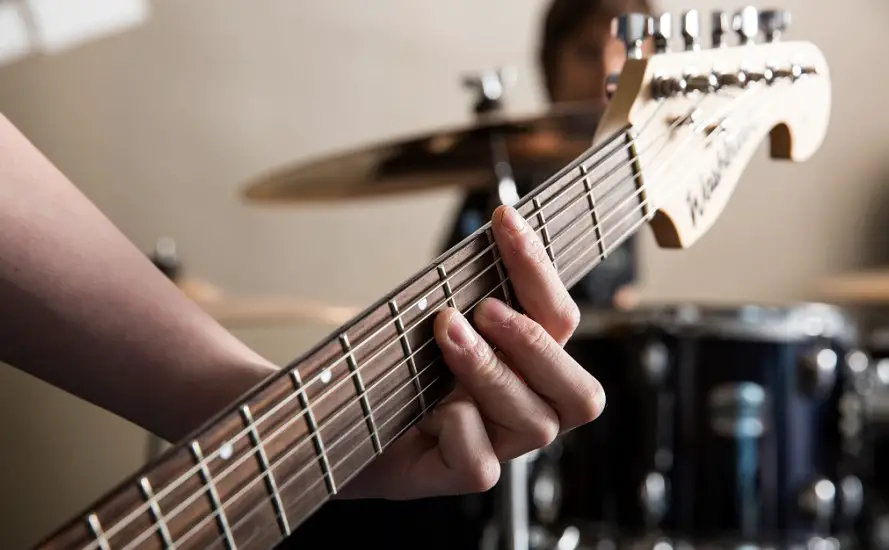
Contents
What are calluses on your fingers
Calluses on your fingers are a result of repeated friction or pressure, usually caused by playing an instrument or performing manual labor. They are thickened areas of skin that form as a natural response to protect the underlying tissue from damage.
Developing calluses are particularly beneficial for guitarists, as they provide a layer of protection against the steel strings, reduce finger pain, and allow for longer playing sessions.
To develop finger calluses, it is recommended to gradually increase the amount of playing time each day and to practice regularly.
You can form calluses through repeated use, taking breaks for extended periods can cause them to soften and eventually disappear.

The advantages of having calluses on your fingertips
While calluses may initially cause some discomfort, they are a natural and beneficial aspect of playing an instrument. In addition to improving your playing abilities, guitar calluses can also prevent injuries such as cuts or blisters.
However, it is essential to maintain proper hygiene and to keep your calluses trimmed to avoid the buildup of dead skin.
Furthermore, if you experience persistent pain or your fingers hurt, it is recommended to take a break and consult a healthcare professional to prevent any potential long-term damage.
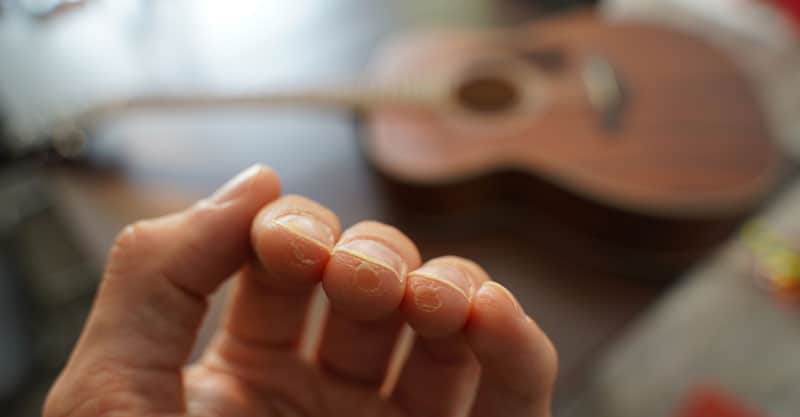
Why proper finger conditioning is essential to play guitar
Proper finger conditioning is essential for playing guitar, as it allows for greater precision and control over the instrument.
Over time, playing the guitar can cause repetitive strain injuries and discomfort, making it important to build up strength and flexibility in the fingers.
This can be achieved through a variety of exercises, such as finger stretches and warm-ups, that focus on improving dexterity and reducing tension in the hands.
Understanding the science of finger conditioning
Building guitar calluses is one of the most significant benefits of finger conditioning for playing guitar.
Guitar calluses are thickened areas of skin that form on the fingertips in response to friction and pressure, providing a natural layer of protection against electric or acoustic guitar strings.
Guitar calluses allow guitarists to play for longer periods without discomfort or sore fingers, making it easier to practice consistently and improve their skills. Guitar calluses also help to develop greater finger strength, as they allow for greater control and accuracy when playing.
Rubbing alcohol or apple cider vinegar is a common method that guitarists use to build calluses for both acoustic and electric guitars. Rubbing alcohol has a dehydrating effect on the skin, which can help harden the skin and build up guitar calluses.
To use rubbing alcohol or apple cider vinegar, simply soak a cotton swab in it and apply it to your fingertips 3-4 times a day. However, it’s important not to overdo it, as pressing too hard or using too much rubbing alcohol can lead to injuries like tendonitis.
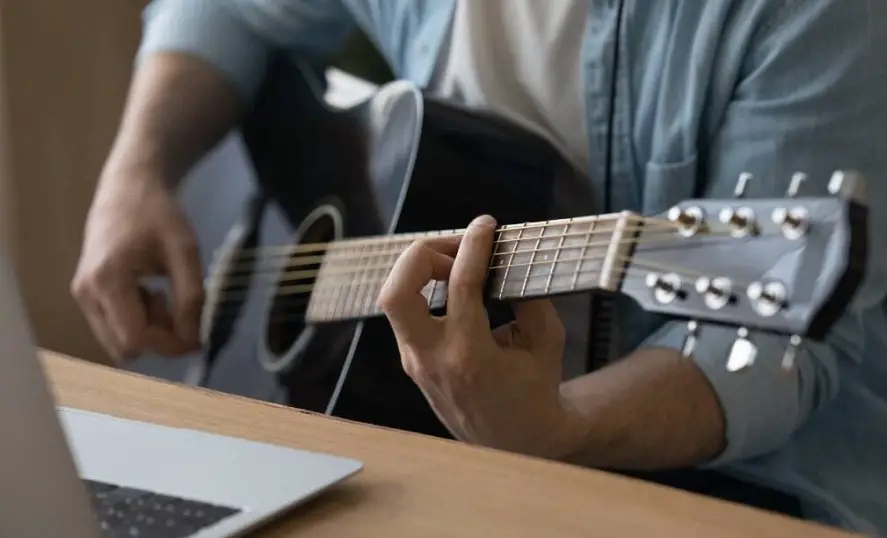
The benefits of building calluses for guitar playing
They provide a natural layer of protection against acoustic guitar strings, which can be particularly beneficial for guitarists. Calluses reduce discomfort and allow for longer playing sessions, as they provide a barrier between the fingers and the guitar strings, making it easier to press down on the fretboard.
Calluses can also improve your playing abilities by providing greater accuracy and control when playing. As they allow for a better grip on the fretboard, they reduce the chances of the fingers slipping or sliding off the acoustic or electric guitar string, leading to improved playing performance. Thus, it is recommended to build calluses for a better guitar-playing experience.
How to toughen fingertips for guitar playing
Building up finger endurance is crucial for extended playing acoustic or electric guitar, as it allows for longer practice sessions and more complicated playing techniques.
One effective way to build up finger endurance is by incorporating finger exercises into your practice routine and gradually increasing the guitar’s playability.
These exercises focus on building strength and dexterity in the fingers and can help to reduce tension and sore fingertips when playing.
Examples of finger exercises include finger stretches, finger tapping, and spider exercises.
Consistency is key, and it is better to practice for shorter periods more frequently than for longer periods less frequently. Taking breaks between playing sessions can also help to prevent sore fingers and promote faster recovery.

How to take care of your fingers during guitar practice
Taking care of your fingers during guitar practice is essential to avoid pain, discomfort, and long-term damage.
One way to take care of your fingers is by stretching and warming up before playing. Finger stretches help to increase blood flow and flexibility in the fingers, reducing the risk of injury and promoting faster recovery.
Another important aspect of finger care is maintaining proper technique. Proper technique can reduce tension and strain on the fingers, minimizing the risk of injury and discomfort.
It is also crucial to take breaks and avoid overplaying, especially when starting or when practicing a new technique. Taking breaks allows the fingers to rest and recover, reducing the risk of injury and promoting faster healing.
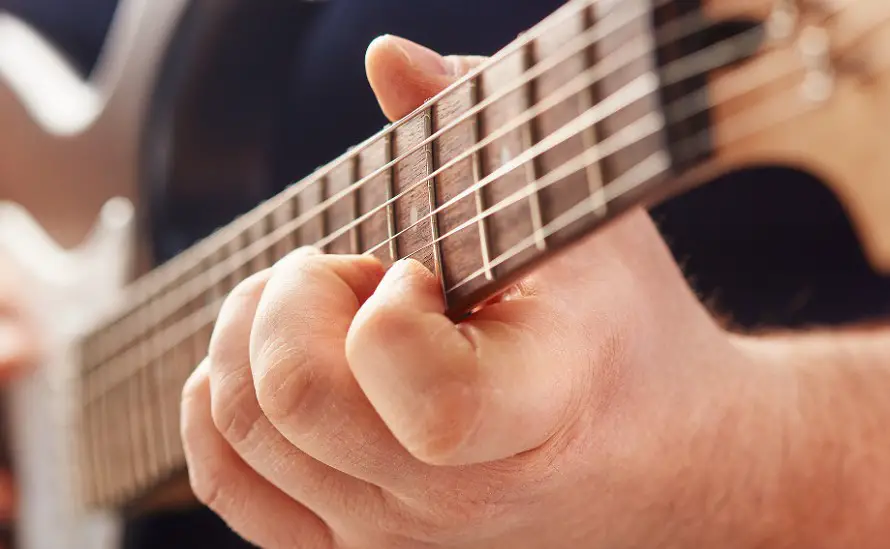
Using hand creams and oils to improve finger health for playing guitar
Using hand creams and oils can help to improve finger health and comfort for playing guitar.
These products can help to keep the skin soft and supple, reducing the risk of cracking or dryness that can interfere with playing ability.
Additionally, some creams and oils contain ingredients that promote healing and reduce inflammation and finger soreness, helping to speed up the recovery process and reduce discomfort.
Essential hand stretches
Essential hand stretches are another important aspect of finger health for playing guitar.
Stretching helps to improve blood flow, flexibility, and range of motion, reducing the risk of injury and discomfort.
Some effective hand stretches for guitarists include making a fist and then extending the fingers as far as possible, gently bending the fingers backward, pressing the palms together, and then spreading the fingers wide.
It is important to perform these stretches slowly and gently, avoiding any sudden or forceful movements that can make your fingers hurt.
Preventing hand injuries
Preventing hand injuries is also a crucial aspect of finger health for guitarists.
Some common hand injuries that can occur from guitar playing include tendonitis, carpal tunnel syndrome, and trigger finger.
To prevent these injuries, it is significant to maintain proper technique and posture, take breaks when necessary, and avoid overplaying or overexerting the hands.
It is also essential to warm up before playing and to stretch and cool down after playing to reduce the risk of injury.

Tips for overcoming finger pain and fatigue
Fatigue and sore fingers are common challenges for guitarists, but several tips can help you overcome these issues.
One effective strategy is to take regular breaks during practice sessions to give your fingers time to rest and recover. This can help to reduce fatigue and prevent the development of finger pain or injury.
Another important tip is to warm up properly before playing. This can help to improve blood flow to the fingers and prepare them for the physical demands to play guitar. Effective warm-up exercises include finger stretches and light playing exercises.
It is also important to maintain good posture and technique while playing an electric or steel-string acoustic guitar. Poor posture can put additional strain, causing sore fingers and pain.
Playing acoustic guitars can be a great way to toughen up your fingertips, especially if you’re just starting and don’t want to deal with the added weight and complexity of an electric guitar.
Acoustic guitars have thicker strings and higher action than electric guitars, which means that you’ll need to apply more pressure to the fretboard to produce clear notes.
This increased pressure can help build up the calluses on your fingertips.
It’s significant to take care of your fingers while practicing on an acoustic guitar, however, as the higher tension of the strings can also lead to finger pain and injury. A good guitar teacher can provide guidance on how to toughen your fingertips while minimizing the risk of injury.
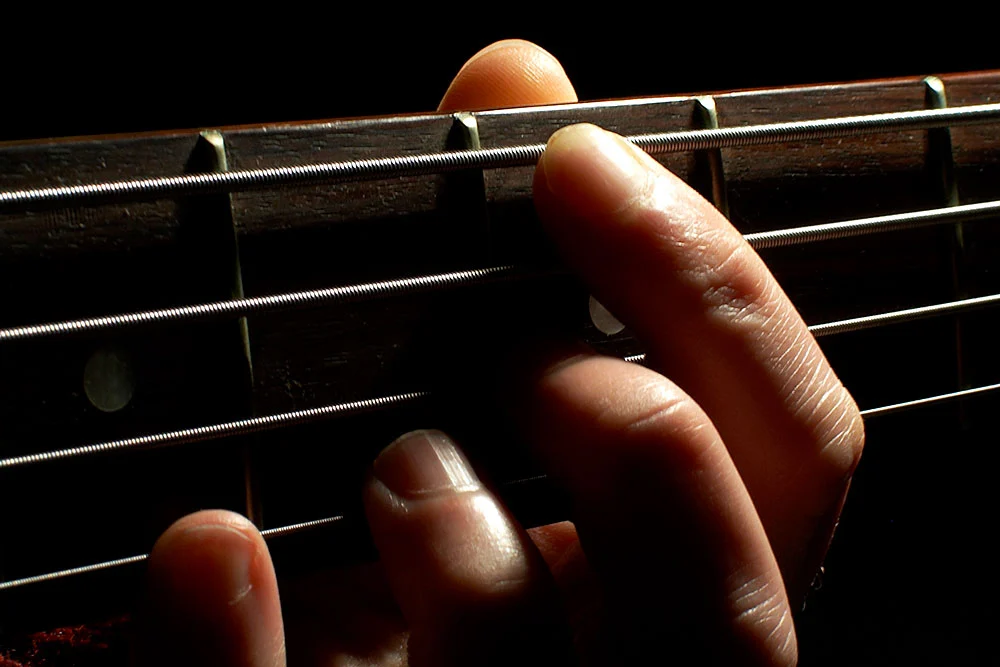
The dos and don’ts of toughening your fingertips
Toughening your fingertips is an important step in building up the endurance and calluses necessary for guitar playing.
Nevertheless, there are several dos and don’ts to keep in mind when working to toughen up your fingertips.
One significant “do” is to practice regularly and consistently. By playing regularly, you can build up the strength and endurance needed to toughen your fingertips.
However, it is essential to start gradually and build up your playing time over time to avoid injury and sore fingers.
Another important “do” is to use proper technique when playing. By using proper technique, you can reduce the risk of injury and improve your overall playing ability.
The good technique also helps to ensure that you are putting the right amount of pressure on the guitar strings, which is significant to develop calluses.
When it comes to “don’ts,” it is important to avoid playing for too long without taking breaks.
Overplaying can lead to fatigue and injury, which can slow down the toughening process. It is also important to avoid playing through pain, as this can lead to more serious injuries and setbacks.
Another “don’t” to keep in mind is to avoid soaking your fingers in water for long periods of time, as wet fingers can soften the skin and slow down the toughening process. Similarly, it is not recommended to play with long nails, as long nails make it harder to develop calluses.

Finding the right balance: knowing when to rest your fingers
Playing the guitar can be a physically demanding activity, and it’s important to know when to rest your fingers to avoid injury.
A buzzing sound while playing guitar can be caused by a variety of factors, including improper finger placement, poor technique, or worn-out heavy gauge strings.
While having calluses on your fingertips can improve your ability to press down on the strings and reduce buzzing, it may not be the only solution to addressing the issue.
One of the most significant factors to consider is how frequently you are practicing. While it’s important to practice regularly, overdoing it can lead to fatigue and pain.
It’s essential to pay attention to your body and take breaks when you need to.
Another factor to consider is the intensity of your practice. If you are playing for extended periods of time, it’s important to take frequent breaks and stretch your fingers to avoid cramping or stiffness.
Another essential factor to consider when finding the right balance is the type of guitar you are playing. Certain guitars, such as steel-string acoustic guitar or electric guitars, may require more intense playing, which can put a greater strain on your fingers.
Common finger pain and injuries
Common finger pain and injuries for guitarists can include blisters, calluses, cuts, and bruises. In more severe cases, guitarists can experience tendonitis, carpal tunnel syndrome, and other repetitive strain injuries. These injuries can result from overuse of the hands and fingers, poor technique, or not giving the hands and fingers enough rest.

How to take care of them
To take care of finger pain and injuries, it is important to practice good technique and take frequent breaks.
Stretching before and after playing can help to prevent injuries and relieve tension.
It is also essential to use proper equipment, such as well-fitted guitar strings and picks that are comfortable to hold. Applying ice to sore or injured fingers can help to reduce swelling and alleviate pain.
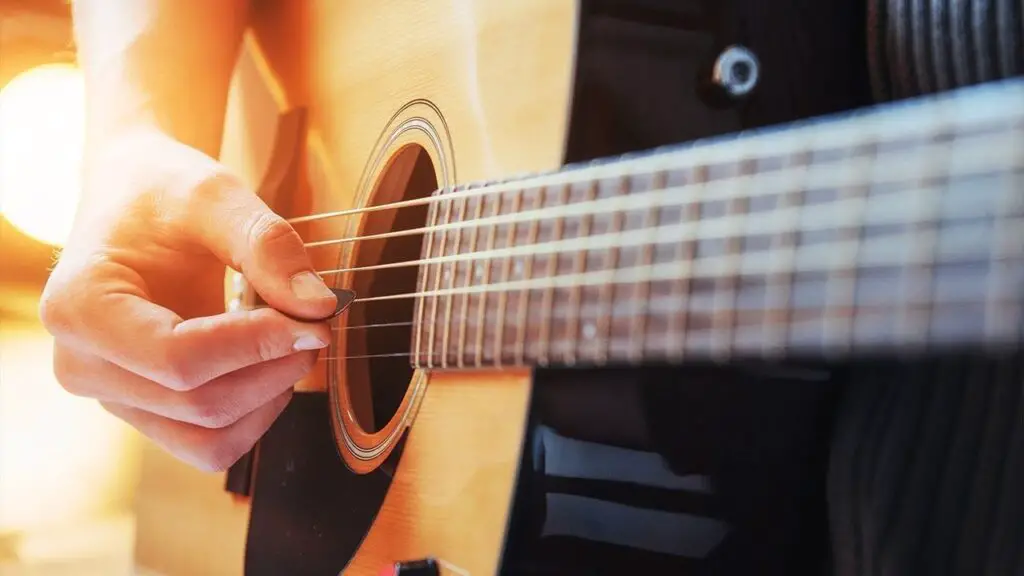
Conclusion
In conclusion, proper finger conditioning is essential for playing guitar, and there are various techniques and methods to help guitarists build up finger strength and endurance while preventing pain and injury.
Building calluses, using hand creams and oils, doing essential stretches, and taking breaks when needed are all crucial aspects of finger care for guitar players.
Additionally, finding the right balance between practice and rest can help prevent common finger pain and injuries. While finger strengtheners may offer some benefits, they are not necessary for building finger strength for playing guitar.
Finally, using an elixir by Eric Clapton or rubbing alcohol can help harden the skin, but it’s essential to use them in moderation to avoid drying and damaging the skin. With proper finger conditioning and care, guitar players can enjoy their instrument for years to come.
FAQ
How long does it take to toughen up fingers for guitar?
How long it takes to toughen up your fingers for playing guitar depends on various factors, including your playing frequency, the amount of pressure you apply, and your overall finger condition.
Generally, it takes several weeks or months of consistent practice to build up the necessary calluses and finger strength to play for extended periods without discomfort.
Do finger strengtheners work for guitar?
Finger strengtheners can be helpful for guitar players to build up finger strength and endurance, but they are not necessary for everyone.
While finger strengtheners can be effective in increasing grip strength and dexterity, it’s essential to use them correctly to avoid causing injury or strain to the fingers.
Furthermore, it’s important to note that simply using a finger strengthener does not automatically translate to improved playing guitar.
It’s still crucial to engage in consistent practice and to use proper technique and form to develop the necessary skills and abilities for playing guitar.
